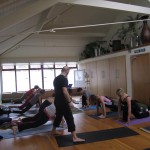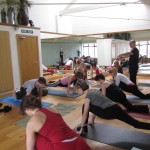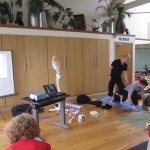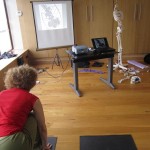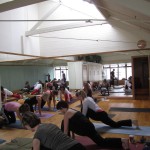- Yoga Weekend Seminar With Gary Carter
- Yoga Weekend Seminar With Gary Carter
- Yoga Weekend Seminar With Gary Carter
- Yoga Weekend Seminar With Gary Carter
- Yoga Weekend Seminar With Gary Carter
With the help of his skeletal friend and sundry other plastic body parts, Gary Carter took over Shambhala Studios and helped us to visualise how the body really works through an in depth knowledge acquired via his own hands-on studies of real life fascia.
I didn’t realise, but there are actually five bandhas – in addition to the ones we all know about in the pelvic floor and diaphragm, they also exist in the throat, the hands and the feet. A bandha is any structure that runs across the body, these are needed to act with the linear supports to maintain posture or we will collapse. But they are not locks, they move with the body to provide cohesion.
There is a peculiar symmetry to the human body with the pelvis and head being of equal weight and the roof of the mouth being connected to the pelvic floor but the head itself is balanced/supported by our feet.
The most memorable thing that I took away from the seminar was ‘make the back of your throat smile’. This is the instruction to bear in mind when trying to work out where your head is meant to be in relation to your body. Too often in yoga postures, I find myself sticking my neck out at strange angles that no longer follow the line of my spine. Thinking about how the back of my throat feels and any tension in it can alert me that my chin is tucked in too far or sticking up in the air.
As Gary pointed out, the spine actually starts level with your nose and you can put it out of alignment in all sorts of positions. For example, when lying in semi-supine, if you have your feet too far away from your bottom, you push the spine up into the head but if they’re too close you feel pressure in your pelvis.
Doing a forward bend, it is important to allow the 14lb weight of your head to be balanced and supported by your feet. Any tension in the neck will affect the integrity of the forward bend and if you’ve got it right, you can feel a sort of lightness in your cheeks. Treat your body like a spring and let it receive the weight and give it back again. Allow the movement to be responsive and fluid.
When on all fours, to find the correct head position, give the head a little shake and feel the back of the throat widen. If your head is too high or too low, you will feel pressure in the throat.
Another memorable point in the workshop was when Gary reminded us that for animals it is the abs that are the ‘floor’ and what we term the pelvic floor is actually a back wall. His feeling was that this is how we as humans should also treat it, since the only part of the area that is actually pointing downwards is the bit around the bladder. The shape of our pelvis and those of animals are the same but our lumbar and psoas muscles have developed to allow us to stand upright. Our pelvic floor should be constantly on the move but, if there is tension or restriction anywhere, it affects pelvic and leg movement as well as digestion.
And finally, when the instruction is to have your feet hip width apart, you should stand so that the space between the two feet is large enough to accommodate the foot of someone facing you. Allowing it to be placed between your feet and touch on either side. Many of us stand far too wide.
I know that some people feel intimidated about practising with the more famous practitioners, thinking it best left to their teachers, who will then bring back bite-sized chunks to class. My experience (from my martial arts background and now in yoga) has always been that it is good to get up close and personal and hear it from the horse’s mouth from time to time. To receive hands-on tuition from the great and the good. Sure, there will be some anatomical terms and language references that may go over your head, but the overall impression is always that you come away with something – even if it is only one small revelation which can reinvigorate or simply change your own practice for the better.
Sadly, work got in the way of my attendance at the Sunday workshop on Breathing but I am hoping to persuade one or two of the other participants to share their views and memories of a remarkable weekend.
Jo Shaer
Click on the individual photographs to make them bigger.
- Yoga Weekend Seminar With Gary Carter
- Yoga Weekend Seminar With Gary Carter
- Yoga Weekend Seminar With Gary Carter
- Yoga Weekend Seminar With Gary Carter
- Yoga Weekend Seminar With Gary Carter

